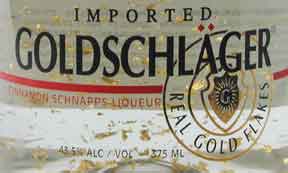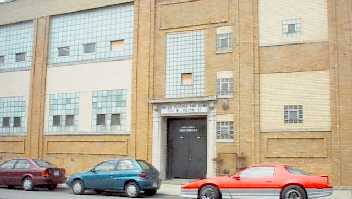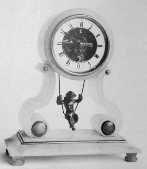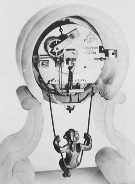Welcome to Roger Russell's
History Page About
MasterCrafters
Accurate Self-Starting Electric Clocks
by Roger Russell
These pages are copyrighted
No portion of this site may be reproduced in whole or in part
without written permission of the author.
![]()
|
I am
a member of the NAWCC |
A very extensive and excellent history of Mastercrafters has recently been published in the October 2004 NAWCC Bulletin. It is titled The Mastercrafters Story by W. Clarke Eldridge and William F. Keller. Pages 619 to 630
About This Page
After doing some research on Mastercrafters, I have found that they made an overwhelming number of different clocks. I have selected only the few that I own or have information to put on this page. I have no further information at this time on these or other clocks that they made and I do not know their present day value.
About Repairs and Parts for These Clocks
I suspect it would be very difficult to find a reliable repair shop, either on the web or locally, that would want to or be able to make these repairs. I have been advised by the only repair shop I knew of that they have decided to stop doing repairs on these clocks. Some of them, such as the swinging girl and fireplace, are so cheaply made that there is no profit in the amount of time and effort needed to restore them. In other words, your cost for restoration could be way beyond what you would be willing to pay. The best place for parts is another clock of the same model that you might find on ebay. Some notes on repairing Mastercrafters Swingers can be found at The British Horological Institute Web Site at (www.bhi.co.uk/hints/cn12.htm).
What's on this Page?
|
General Information |
Action Starlight |
Mastercrafters went into business just after WWII and it was not until 1980 that they closed their doors. The original name was Mastercrafters Clock and Radio Company but by 1948 they abandoned the radio manufacturing business and got full blown into the novelty clock business. Benjamin Lerman was President and owner. Later, Bernie Ellman, who married Ben Lerman’s daughter, gradually assumed control of the company. Ben Lerman had been awarded several patents assigned to Mastercrafters.
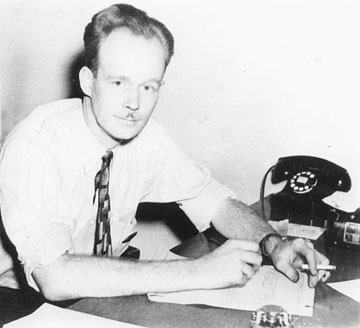 John Lane Hancock was the chief designer and
electrical engineer at Mastercrafters from the late 1940’s until his death in
September of 1976 at age 67. He lived in Villa
Park, IL, about 15 miles west of Chicago. He
designed many of the Mastercrafters clocks. Here’s John busy at his desk
working on a paper. There’s a clock mechanism near the bottom of the picture.
The photo was taken in the late 40’s or early 50’s. John was a brilliant clock
designer. There were dozens of clocks in every room of the house, even the
bathroom. When John wasn’t testing new motors or designing beta versions of his
new clock designs, he was restoring antique clocks. He was a big 6’ 2” portly
man with flaming red hair and piercing blue eyes. His family referred to him as
John HanCLOCK!
John Lane Hancock was the chief designer and
electrical engineer at Mastercrafters from the late 1940’s until his death in
September of 1976 at age 67. He lived in Villa
Park, IL, about 15 miles west of Chicago. He
designed many of the Mastercrafters clocks. Here’s John busy at his desk
working on a paper. There’s a clock mechanism near the bottom of the picture.
The photo was taken in the late 40’s or early 50’s. John was a brilliant clock
designer. There were dozens of clocks in every room of the house, even the
bathroom. When John wasn’t testing new motors or designing beta versions of his
new clock designs, he was restoring antique clocks. He was a big 6’ 2” portly
man with flaming red hair and piercing blue eyes. His family referred to him as
John HanCLOCK!
Among many of his designs was the waterfall clock. This was inspired by a Hamm’s beer display that featured a similar waterfall. He was an avid beer drinker and a fisherman.
He got his inspiration for the Model 47 Action Starlight tube clock from an interesting German liqueur called Goldwasser, clear liquid with gold leaf flakes suspended in it. A parts supplier gave him several bottles one year as a Christmas gift. Today it’s sold as Goldschlager. He had dozens of vials of test liquid all over the house, testing the suspension of the particles in relation to the viscosity of the fluid. The heat from the bulbs that illuminated the tubes set the particles in motion. Although the exact formulation for the fluid is not known, it could be a combination of mineral oil, alcohol and other fluids.
|
|
|
|
An article in the Villa Park Argus newspaper was written about him. The date was probably 1953 –1955. The picture that accompanied this article is a third or fourth generation copy and is not clear enough to publish on this page.
“Villa Park Horologist Expert Finds Time Does Not Hang Heavily
John Hancock, 303 E. Division St., Villa park, an electronics engineer and holder of more than 20 patents involving mechanical and electrical clock improvements, is a busy man. So busy, in fact, that he hasn’t time to keep up with his own extensive clock collection… However, Hancock, who is chief engineer for the Mastercrafters clock concern, believes that “any clock is repairable.” In Hancock’s collection is a clock dating back to 1807, which has no steel parts at all. Instead of screws and nuts, it is held together by pegs. It has wooden gears and ivory bearings. Hancock, who recalls being spanked at the age of five for taking apart his mother’s expensive French clock, is still fascinated by clocks. One of his patents is for an electric motor unique in the clock field. A clock involving a mechanical principle “dreamed up” by the Villa park engineer has sold half a million models in the past three years.”
As teenagers his three daughters worked in the office at the West Fulton Street address. My thanks to John’s two surviving daughters, Laraine and Johanna, for the valuable information about their father and the company.
![]()
Several different company addresses have been found:
|
|
Here's a picture of the building at 1750 West Fulton Street in Chicago. It's now occupied by United Feather and Down. Thanks to Ron Hoth, who took this picture in May of 2000. |
|
|
Mastercrafters Clock and Radio Company |
Mastercrafters Clock Corporation |
|
|
Mastercrafters Clock and Radio Company |
Mastercrafters Clock Company |
|
|
|
|
|
A mermaid clock, model 4740, and a Breyer horse have been found with the name Ceramic Clock Company, 216 N. Clinton Street, Chicago 6, Ill. This is the same address that was found on the model 272 Fireplace clock. A patent number 1,971,150 has also been found on the mermaid clock. This patent is titled Scenic Display Device and was awarded to J. J. Anderlick on August 21, 1934. It was filed on May 16, 1933 #671,393. It was assigned to be divided equally between Benjamin Lerman and Jacob G. Ward, both of Chicago.
![]()
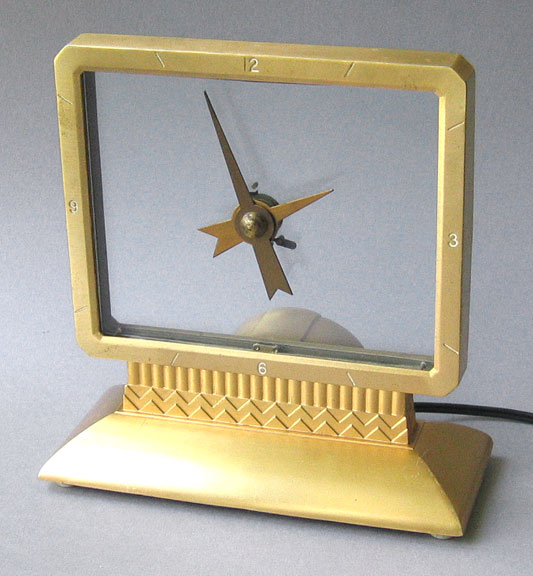
Model 209
. This is often referred to as the Mastercrafters "Mystery Clock" because no model name is on the base. For some reason the name Fantasy was on a tag attached to the line cord, which was apparently removed when the clock was put to use. The appearance of hands floating in the air is similar to the Jefferson Golden Hour but the frame is rectangular. Therefore, the glass cannot rotate to advance the time.
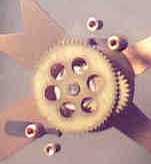 This clock operates in a very unusual way. There's a
piece of glass in the front and the back. In between is a sheet of transparent
plastic. The hands are mounted at the front of the front glass. The plastic
sheet pivots at the top of the frame and moves side to side very slowly. It has
four pins attached to it near the center. The picture at the right is at the
rear of the hand assembly. Two black ratchet arms are used, one at a top pin
and one at a bottom pin. They turn freely and both fit in cogs of the large
ratchet gear. At the extreme left and right excursion of the plastic sheet, one
of the arms advances the large gear, then the other. This turns the minute hand
and gears that drive the hour hand. The other two pins that appear to be
floating in the picture apparently prevent the arms from rotating too far out
of place if the clock is turned over like it might be in shipment. The back
glass serves as a cover.
This clock operates in a very unusual way. There's a
piece of glass in the front and the back. In between is a sheet of transparent
plastic. The hands are mounted at the front of the front glass. The plastic
sheet pivots at the top of the frame and moves side to side very slowly. It has
four pins attached to it near the center. The picture at the right is at the
rear of the hand assembly. Two black ratchet arms are used, one at a top pin
and one at a bottom pin. They turn freely and both fit in cogs of the large
ratchet gear. At the extreme left and right excursion of the plastic sheet, one
of the arms advances the large gear, then the other. This turns the minute hand
and gears that drive the hour hand. The other two pins that appear to be
floating in the picture apparently prevent the arms from rotating too far out
of place if the clock is turned over like it might be in shipment. The back
glass serves as a cover.
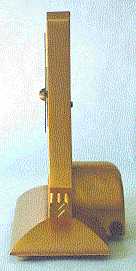 Instructions on the bottom plate say "These three
screws not to be loosened. To remove base loosen the four rubber legs.
Guarantee is void if seal is broken. To set time--turn minute hand only in
clockwise direction."
Instructions on the bottom plate say "These three
screws not to be loosened. To remove base loosen the four rubber legs.
Guarantee is void if seal is broken. To set time--turn minute hand only in
clockwise direction."
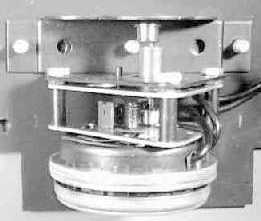 A Sessions Clock Company synchronous motor is in the
base. A worm gear from the motor drives several other gears that turn a wide
shaft with an eccentrically mounted wheel. The wheel can be seen near the top
of the picture. This wheel is positioned in a U shaped bracket attached to the
plastic that is between the front and back glass. The side to side motion is
caused by the eccentric wheel.
A Sessions Clock Company synchronous motor is in the
base. A worm gear from the motor drives several other gears that turn a wide
shaft with an eccentrically mounted wheel. The wheel can be seen near the top
of the picture. This wheel is positioned in a U shaped bracket attached to the
plastic that is between the front and back glass. The side to side motion is
caused by the eccentric wheel.
The numbers 3, 6, 9, and 12 are in the metal frame. Radial lines are at the other hours. The clock is 8-1/2" high (including feet), 8 1/4" wide and 4-1/4" deep. The dial frame is 6-1/4" high, 7-1/4" wide and 3/4" deep. There is no light. The address on this clock is Mastercrafters Clock and Radio Company, 216 N. Clinton Street, Chicago 6, Illinois. Power requirement is A.C., 110V 60 cycle, 2.5 watts. Weight is 3.6 lbs.
![]()
Smiths and Jaeger Clocks
Another mystery is the relationship between Smiths and Jaeger. Here, the clocks seem to be identical except for the name and paint on the hands. Although the name Jaeger appears on the dial glass, the bottom plate says “Made in England.” This indicates that the clock was made by Smiths and sold by Jaeger with their name on it.
|
|
|
|
Smith Electric |
Jaeger Electrique |
|
|
|
|
Jaeger Time Adjust Knob |
Jaeger Bottom Plate |
This clock was patented in 1934. The principle method of operation may predate the Mastercrafters Fantasy clock. There are three pieces of glass. The front piece has the numerals. The rear plate has a hole in the center with a pin that supports the center glass and the hand assembly. The center glass moves imperceptibly slowly to advance the hands and is driven through a roller arm and motor in the base. The finish is nickel.
![]()
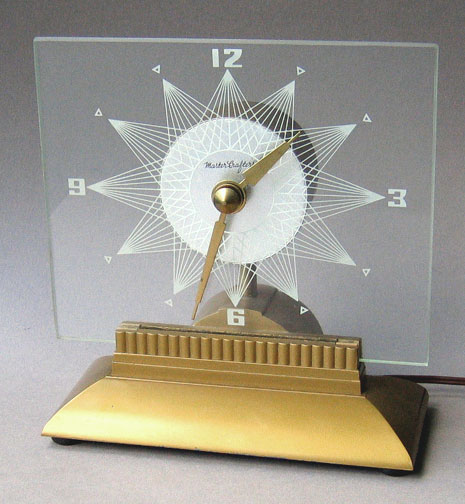
Model number 146
The glass is 8-1/2" wide and 7" high. It's 7/32" thick and is frosted around the edges. There is a light in the base that illuminates the etched patterns on the glass as well as the edges. There is also an on-off switch in the back for the light. Numerals are at 3, 6, 9 and 12 o'clock and small triangles are at the other hours. The motor is located behind the center white area. The power cord runs down a small hollow tube to the base.
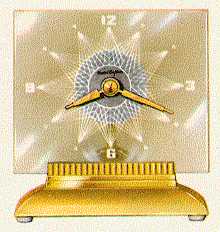 The cast base is made of a lightweight metal--possibly
gold anodized aluminum. The clock is UL approved. Size is 8-3/4" high,
8-1/2" wide and 4-1/4" deep. It has four rubber feet under the base.
It weighs 3.2 lbs.
The cast base is made of a lightweight metal--possibly
gold anodized aluminum. The clock is UL approved. Size is 8-3/4" high,
8-1/2" wide and 4-1/4" deep. It has four rubber feet under the base.
It weighs 3.2 lbs.
The clock has been advertised in a 1959 N. Shure Co., Chicago, Ill. catalog as the "Television Starlight." The ad picture is at the right. The text says:
"The perfect T.V. clock! 1/4 in. plate glass dial is illuminated by means of a pin switch. Soft glow complements any room and is excellent for T.V. viewing. Satin gold finish, metal base, 9" high, 8-1/2" wide, 4-1/2 lbs. Retail $16.95"
![]()
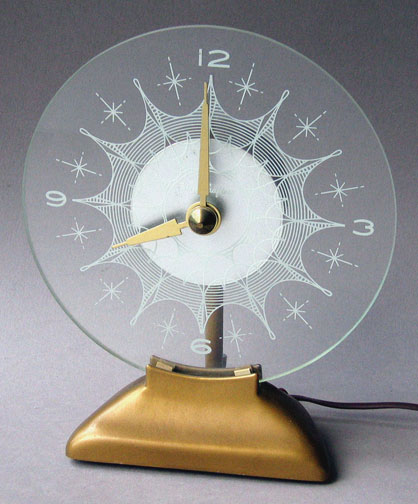
Model 416
This clock is similar to the Starlight but round. Numerals are at 3, 6, 9 and 12 o'clock and points in the decorative pattern are at the other hours. There is a light in the base that illuminates the etched patterns on the glass as well as the edges. A light switch is located in the back. The motor is located behind the center white area. The power cord runs down a small hollow tube to the base. The glass is 8" in diameter and the overall height is 9-1/2". The cast base is made of a lightweight metal--possibly gold anodized aluminum. The clock is UL approved.
![]()
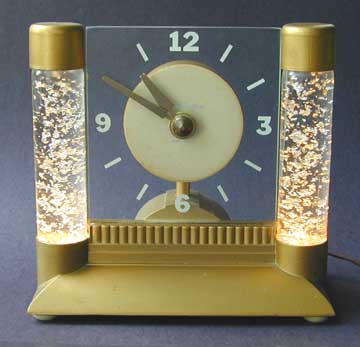
Model 47
There is a light under each glass cylinder that heats up the liquid inside and convection currents circulate small pieces of silver colored foil that reflect the light to create an outstanding display. A switch in the back turns off the lamps and the motion will stop.
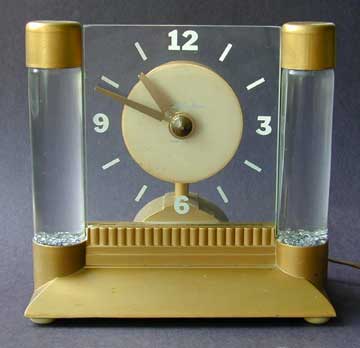 Numerals are at 3, 6, 9 and 12 o'clock and small lines are
at the other hours. The motor is located behind the center area. The power cord
runs down a small hollow tube to the base. The cast base is made of a
lightweight metal--possibly gold anodized aluminum. Size is 8-1/2" wide
and across and 8" high. The clock is UL approved.
Numerals are at 3, 6, 9 and 12 o'clock and small lines are
at the other hours. The motor is located behind the center area. The power cord
runs down a small hollow tube to the base. The cast base is made of a
lightweight metal--possibly gold anodized aluminum. Size is 8-1/2" wide
and across and 8" high. The clock is UL approved.
There are two versions of numerals for this clock. In the second version, the numerals are of a more flattened design.
A label on the back says:
"Model No. 47 Action Starlight.
To operate clock, plug into electric outlet. Set to correct time. Action in glass tubes is controlled by light in base of clock. Turn light switch on. The action will start in 2 to 5 minutes. If quicker action is desired, pull the glass tubes out of base and gently shake them, then replace in openings in base. To replace bulbs remove the screw in each of the four rubber feet in base of clock. Replace only with 10C7 bulbs.
Mastercrfters
Clock Corp., 1705 W. Fulton Street, Chicago, Illinois 60612
25W, 115V, 60CY A.C."
![]()
Magic Lite
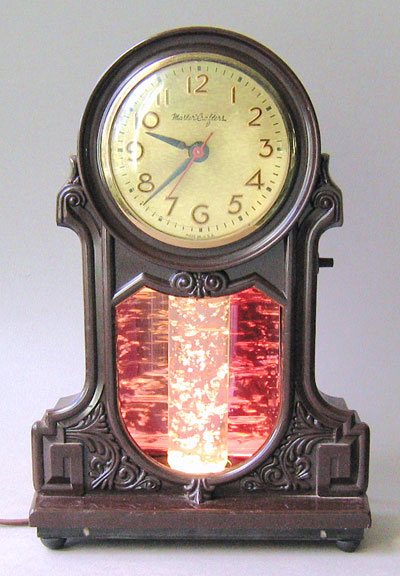
Model 434
This is commonly referred to as a "Glitter Tube" clock because there is no name on the label. Although there is only a single tube, the red curved reflector creates a much more spectacular display than the Action Starlight. The glitter is silver colored and slowly circulates around, reflecting the light from the lamp in the base and then being reflected and broadened by the curved piece. The single lamp can be turned on and off using a switch shown at the right side of the clock.
Size is 11" high, 7-1/2" wide and 3" deep. The dial face is gold colored and the Tenite plastic case is dark brown. Power requirements are 13W, 115V, 60CY A. C. Mastercrafters Clock Corp, 1750 West Fulton St., Chicago, Illinois 60612
Instructions on the back label say:
"To operate the clock, plug into electric outlet. Set to correct time. Action in glass tubes is controlled by light in base of clock. Turn light switch on. The action will start in 2 to 5 minutes. If quicker starting is desired, gently lay clock on back and then immediately place in upright position. To replace bulb remove 2 smaller screws near ends of clock base. Replace only with 10C7 bulb."
![]()
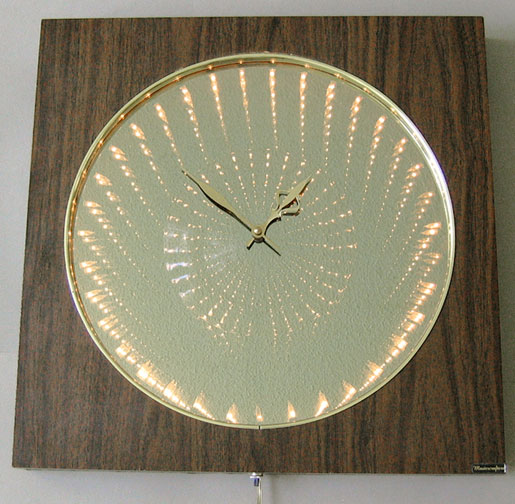
Model 524
Here is a most unusual clock. Thirty five
small incandescent lamps are arranged in a circle. An 8” in diameter spherical
surface mirror is the center. Behind that is a 4-section flat mirror 16” in
diameter. The front glass of the clock is partially silvered to produce the
illusion of depth using multiple reflections. As you move around the clock, the
direction of the multiple reflections appears to change. When the lights are
turned off, the clock appears to be a dark mirror with 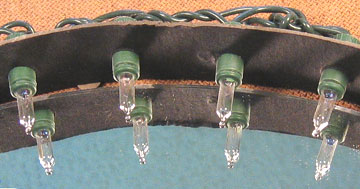 the two hands in the center.
the two hands in the center.
The back cover is made of 1/8” Masonite and holds the mirrors and lamp assembly. The lights are mounted in a circular piece of cardboard shown at the left. A reflection of them can be seen below the real ones. Each lamp can be removed from its socket for replacement. A switch for the lights is located at the bottom in the center, where the power cord also exits.
The name Mastercrafters is in the bottom right corner. The case is walnut grain vinyl over particle board. A cold-colored ring hides the wood around the edge of the mirror. Two picture supports are provided on the back to hang the clock on the wall. The clock is 19-1/2” square and 2-1/4” deep. It is UL listed. Weight is 12 lbs. 120V 60HzAC 20 watts. Max. Lamp Size 3.5 Volt. Mastercrafters Clock Corp., Chicago, IL 60622
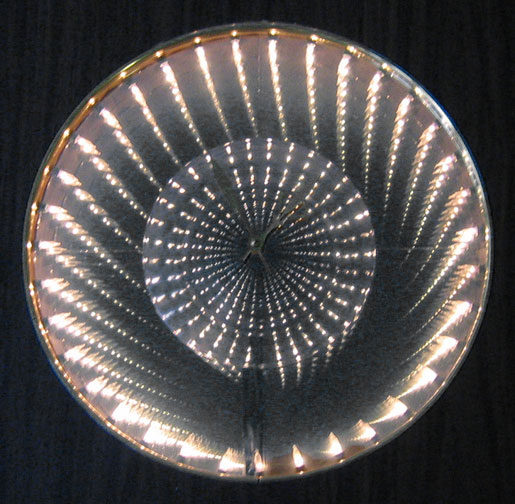
At night, the display is very dramatic. The lights will illuminate the entire room.
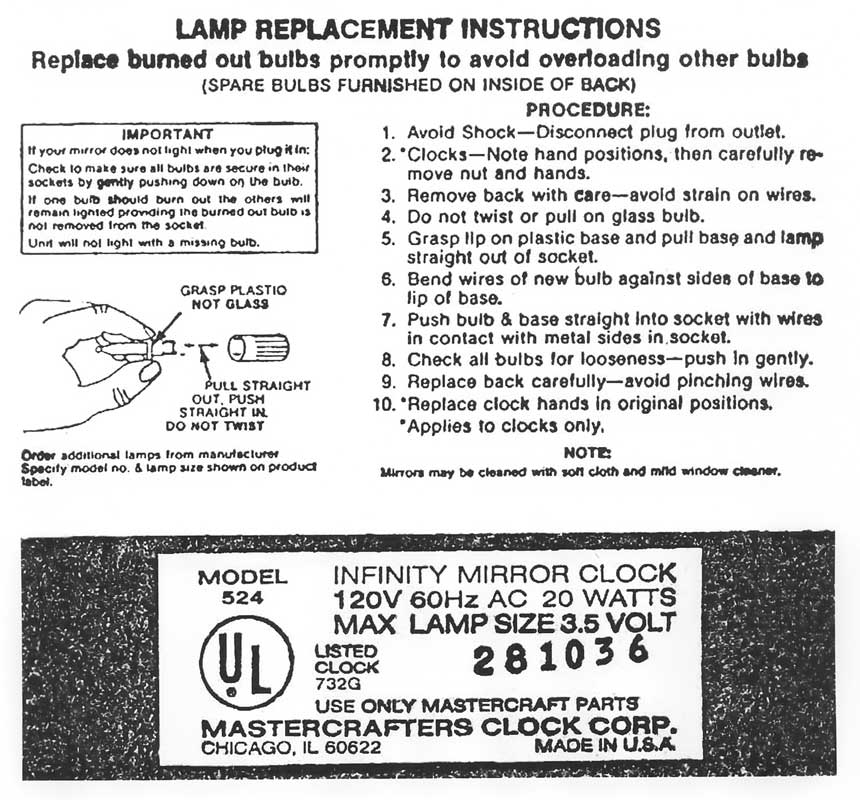
![]()
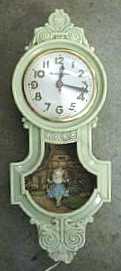
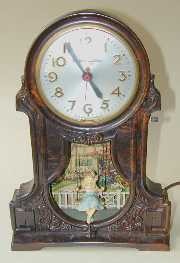 Model 119. Also known as Mantel Swingtime or Girl on a
Swing. This was the first motion clock to be made by Mastercrafters.
Model 119. Also known as Mantel Swingtime or Girl on a
Swing. This was the first motion clock to be made by Mastercrafters.
It has a light switch on the right side. The clock I have measures 10-1/4" high, 7-3/8" wide at the bottom and 3-1/8" deep. The window for the girl and scene is 3-1/2" wide and 4" high. The clock weighs 875 grams or about 1.9 pounds.
The clock dial is 4' in diameter and has a gold colored border. The numerals are raised gold and colored with a black line along the center. The hour and minute hands are black and the second hand is red. The word Mastercrafters is written in script above the center of the dial. The words "Clock Movement by Sessions" is written in small print around the bottom of the dial.
This clock was also available in a wall version model 227, also known as Wall Swingtime. It came in green onyx or walnut finish.
On the back of my mantel clock a label reads:
"Push In To Set. Pat. No. D152808 and other patents pending. A. C., 110V
60 cycle, 2.5 watt movement. To replace bulb: remove nuts and screws on back
plate. Use a 6 watt 110V candelabra bulb. Mastercrafters Clock and Radio
Company, 216N Clinton St. Chicago 6, Ill. Pat. No. 2507026"
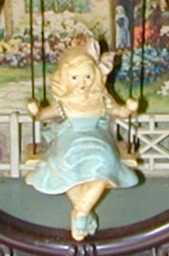 Design patent Des. 152,808 was awarded to Ben Lerman, Chicago, Ill. on Feb, 22, 1949 for
this clock. It was assigned to Mastercrafters Clock & Radio Co., Chicago, Ill. Patent
was applied for on August 23, 1948. It is titled "Design for a Clock." The
illustrations show the clock, swinging girl and mechanism but only in outline.
The case is not shown.
Design patent Des. 152,808 was awarded to Ben Lerman, Chicago, Ill. on Feb, 22, 1949 for
this clock. It was assigned to Mastercrafters Clock & Radio Co., Chicago, Ill. Patent
was applied for on August 23, 1948. It is titled "Design for a Clock." The
illustrations show the clock, swinging girl and mechanism but only in outline.
The case is not shown.
Patent number 2,507.026 was awarded to Ben Lerman, Chicago, Ill. on May 9, 1950. It was assigned to Mastercrafters Clock & Radio Company, Chicago, Ill. and is titled simply "Clock." The patent was applied for on Aug. 26, 1948. It describes the mechanism and shows the figure of the swinging girl. It is thought that John Hancock, who was the chief designer at that time, was the originator of this invention.
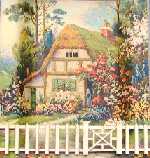 Two scenes have been found for the background of the
swinger. One is a Country house with a thatched roof, trees and lots of
flowers. The white fence in front of the scene is separate and is made of
plastic. The scene is glued to the contoured metal back of the clock.
Two scenes have been found for the background of the
swinger. One is a Country house with a thatched roof, trees and lots of
flowers. The white fence in front of the scene is separate and is made of
plastic. The scene is glued to the contoured metal back of the clock.
The second version has a more modern ranch style house. A third version has a country scene behind the swingers with a brook, bridge, trees, houses and mountains in the distance. This one is pictured in the description of the Swinging Playmates clock. I have not yet found a reliable source for who the artist is that created the backgrounds. One possibility is R. Atkinson Fox.
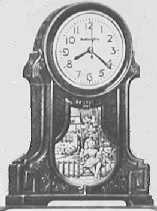 In 1951, the clocks were advertised as "The
Swinging Girl" in a wholesale catalog.
In 1951, the clocks were advertised as "The
Swinging Girl" in a wholesale catalog.
Joseph Hagn Company, 223 West Madison
Street, Chicago 6, Illinois.
 "Full color garden scene is beautifully
illuminated by indirect light. Brings out colors in full splendor...also serves
as a night light controlled by pin switch on side of case.
"Full color garden scene is beautifully
illuminated by indirect light. Brings out colors in full splendor...also serves
as a night light controlled by pin switch on side of case.
Mantel Swingtime...Gloriously captures the charm of childhood's golden days...so true-to-life that it actually transports you to an exquisite springtime garden where a lovely girl joyously swings beside a rustic gate. The automatic swinging action of the beautifully detailed girl-figurine is amazingly realistic...a built-in indirect night-light marvelously enhances garden scene. Self-starting electric movement...Tenite plastic case in walnut or onyx finish...height 10-3/4", width 7-3/4", depth 3"...individually packed...weight 3-1/2 lbs. Retails at...$15.95... 5C119 ea. $9.57"
Wall Swingtime...Tenite plastic case, walmut or Onyx finish. Height 14-1/2", width 5-3/4", depth 2-3/4". Individually packed, wt. 3 lbs. Retails at...$15.95... 5C119 ea. $9.57"
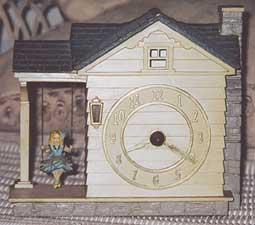 Here’s a Swinging Girl clock that is rarely seen. It
has no model number. This clock is part of the estate of the late John Hancock.
Thanks to his daughters Laraine and Johanna for the picture.
Here’s a Swinging Girl clock that is rarely seen. It
has no model number. This clock is part of the estate of the late John Hancock.
Thanks to his daughters Laraine and Johanna for the picture.
|
|
The idea of a swinger clock is not new and goes back to a time before electric clocks. In this clock, the figure is actually the pendulum. A special form of anchor escapement was patented in 1862 by Farcot of Paris. Instead of having the figure swinging side to side as in conventional clock pendulums, the figure swings forward and backward. |
|
The above clock has a white alabaster case with some ormolu trim and a gilt metal cherub on the swing. In the front view, a portion of the mechanism can be seen through the center of the dial. The two pictures and description of this early clock are from "Collectable Clocks 1840-1940" 3rd edition by Alan & Rita Shenton, The Antique Collector's Club, 5 Church Street, Woodbridge, Suffolk, England. ISBN 1 85149 195 3
![]()
Swinging playmates
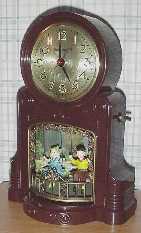 Model 551. This motion clock is made of plastic and
came in a green onyx or a walnut finish. It has a light switch on the side.
Measurements are 10 3/4" high, 7 3/8" wide and 4 3/4 " deep. The
frame for the scene is 4"x4."
Model 551. This motion clock is made of plastic and
came in a green onyx or a walnut finish. It has a light switch on the side.
Measurements are 10 3/4" high, 7 3/8" wide and 4 3/4 " deep. The
frame for the scene is 4"x4."
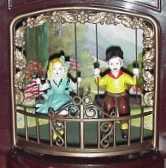 Three labels on the back of one clock say "Model
551 Swinging Playmates, 120V. 60 Hz. A. C. 9.5 Watts. Mastercrafters Clock
Corp, Chicago, ILL 60622. Made in U. S. A. UL Listed Clock 732G. The second
label says "Lamp Replacement, Avoid shock--disconnect clock. Remove back
with care to avoid strain on wiring. Use 7 watt maximum lamp size. Replace
back, using care so wires are not pinched." The third label says
"This clock has been tested and inspected. Do not remove this label.
184016. Mastercrafters Clock Corp., Chicago, Ill."
Three labels on the back of one clock say "Model
551 Swinging Playmates, 120V. 60 Hz. A. C. 9.5 Watts. Mastercrafters Clock
Corp, Chicago, ILL 60622. Made in U. S. A. UL Listed Clock 732G. The second
label says "Lamp Replacement, Avoid shock--disconnect clock. Remove back
with care to avoid strain on wiring. Use 7 watt maximum lamp size. Replace
back, using care so wires are not pinched." The third label says
"This clock has been tested and inspected. Do not remove this label.
184016. Mastercrafters Clock Corp., Chicago, Ill."
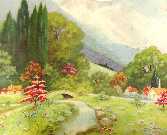 A single label on an earlier clock says "Model
No. 551 Swinging Playmates, Use 7 watt bulb, A. C., 115V, 60 cycle, 9.5 watts,
Made in U. S. A. by Mastercrafters Clock Corp., 1750 West Fulton Street, Chicago, Illinois, 60612. UL Approved"
A single label on an earlier clock says "Model
No. 551 Swinging Playmates, Use 7 watt bulb, A. C., 115V, 60 cycle, 9.5 watts,
Made in U. S. A. by Mastercrafters Clock Corp., 1750 West Fulton Street, Chicago, Illinois, 60612. UL Approved"
There is a country scene behind the swingers with a brook, bridge, trees, houses and mountains in the distance.
This clock was sold as early as 1952 and at
that time it was $15.95.
Thanks to Yvonna Stockel-Brewer for the pictures and information.
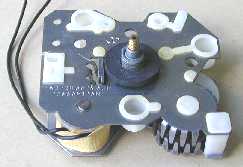 This movement is made by Sunbeam. It has been found in
more recent models of the Fireplace, Waterfall, Swinging Playmates and Happy
Times. Earlier models use a round Sessions movement. This movement is not
interchangeable with the Sessions movement. I understand that the Sunbeam
assembly is very inexpensive and not looked upon favorably by repair services.
This radically different assembly consists of many plastic parts, including
many of the gears. They are held in place by two steel plates and three screws.
The plates are roughly square in appearance.
This movement is made by Sunbeam. It has been found in
more recent models of the Fireplace, Waterfall, Swinging Playmates and Happy
Times. Earlier models use a round Sessions movement. This movement is not
interchangeable with the Sessions movement. I understand that the Sunbeam
assembly is very inexpensive and not looked upon favorably by repair services.
This radically different assembly consists of many plastic parts, including
many of the gears. They are held in place by two steel plates and three screws.
The plates are roughly square in appearance.
A coil is located at the bottom left of the picture. The coil creates an alternating magnetic field in the two plates. Two sets of steel teeth are at the bottom right, one set from the upper plate and one set from the lower plate. Each set is in a semicircle. Where they mesh with each other without touching, an alternating magnetic field is created across the gaps. A ferrite disc inside the circle is magnetized at several places around the perimeter. This interacts with the AC field and causes the magnetic disc inside to rotate in synchronism with field. The teeth are offset slightly so that the motor starts in the correct direction. A gear on the same shaft as the disc drives the rest of the gear train for the hands and the motion device.
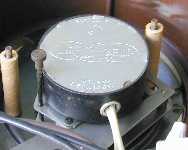 Early clocks use a motor shown at the left with the
Mastercrafters name on it. It has a black cylindrical case 2" in diameter
and 3/4" high. The motor is mounted on a steel plate. A second similar
plate is attached to it underneath with 3/8" metal spacers. The two
cardboard standoffs, left and right, keep the back cover in proper position.
The time set knob can be seen near the left standoff.
Early clocks use a motor shown at the left with the
Mastercrafters name on it. It has a black cylindrical case 2" in diameter
and 3/4" high. The motor is mounted on a steel plate. A second similar
plate is attached to it underneath with 3/8" metal spacers. The two
cardboard standoffs, left and right, keep the back cover in proper position.
The time set knob can be seen near the left standoff.
The back plate on the motor is stamped as follows:
"Model #11, Master Crafters Clock Company, Chicago, U.S.A., 115V. A. C., 2.5W, 60 CY." A UL symbol is also stamped in the plate. This motor is in an older Fireplace clock.
![]()
Other Clock Pages I Have Created
|
A history of the Jefferson Electric Company including many mystery clocks and other products. Lots of pictures and text. |
|
|
A major Chicago competitor to Jefferson that made similar mystery clocks and also animated clocks. |
|
|
Mystery clock page includes Etalage, Etalage Reclame, Sonic Industries Inc., Monitor Equipment Corp. MagiClock, Boots Boy and Rex Cole. |
|
|
Includes very early and late clocks from companies other than those already listed. |
|
|
Also known as projection clocks. A history of these interesting clocks from 1909 to present. |
![]()
